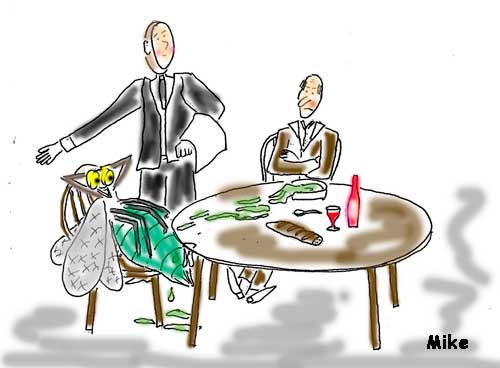How to write (and tell) jokes in Spanish (quick course)...
LESSON 1
1) First you need to read some enlightening material to motivate you to write! Here is a very funny joke:
Una Mesa para Dos
Hay un tío que vive en Madrid. Le gusta frecuentar los restaurantes; y más que todo le encanta la sopa. Un día, entra en un restaurante y dice al camarero:
-Buenas noches. ¿Tiene usted una mesa para uno? (1*)
-Pues, no, señor- contesta el camarero-, pero tengo una mesa para dos-. El tío se queda allí un poco confuso pero al final pregunta:
-Bueno, ¿y puedo sentarme allí?
-Muy bien- contesta el camarero-. Sígame, por favor. Van los dos a una mesa y el tío se sienta y entonces dice:
-Quiero una sopa de verdura, por favor.
-Muy bien- dice el camarero y vuelve con un plato de sopa de verdura. Y dice el tío:
-Gracias. Pero, oiga, usted. ¡Hay una mosca en esta sopa!- Y el camarero contesta:
-Pues, es verdad, señor, pero no se queje usted. Esta es una mesa para dos. (2*)

( Glossary: tío = guy / bloke, frecuentar = go to, sopa = soup, una mesa para uno = a table for one, contesta = answers, El tío se queda allí un poco confuso = The guy is a bit confused, pregunta = asks, sígame = follow me, los dos = both of them, verdura = vegetables, oiga, usted = Hey!, mosca = fly, es verdad = that's right, no se queje usted = don't complain. )
2) That was very funny, wasn't it? But don't get carried away with excitement yet; before you write your first wonderful joke in Spanish, take note of these technical points:
a) The whole joke is in the present tense! (When a native speaker tells a joke or talks about recent news among friends, they often use the present. It makes everything sound more immediate.)
b) Note the punctuation. Speech marks are substituted for the dash ( - ) and do not close the spoken
text if...
1) somebody else speaks immediately after (see *1) or
2) a new paragraph starts immediately after (even though it is not dialogue.)
3) the dialogue finishes the story (see *2)
c) You can insert 'dice el hombre', 'el hombre dice', 'contesta el camarero,' 'el camarero contesta', throughout your joke to make it clear who is speaking and make it sound as though delivered orally. Avoid literary adverbs like 'dice el hombre cordialmente' (he said politely) if you want your joke to sound the same as it would be spoken. Keep sentences short and sharp.
d) Here the word 'tío' is used. This could be translated as 'guy' . eg. 'this guy says' (GB. 'bloke') ('el tío dice'). For a woman, the word 'tía' is common. This is very colloquial and common in Peninsula Spanish (from Spain.) These words are also used to talk to somebody directly: 'Oye, tío, ¿qué pasa? ('Hey, man. What's up?) Alternatively, the term 'un hombre', 'una mujer', or if they are children, 'un niño', 'una niña' or for more respect when referring to adults, 'un señor', 'una señora,' or even 'un caballero', 'una dama'.
Copyright 2022 English Spanish Link
All rights reserved